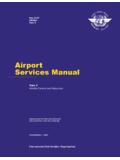Transcription of Hospital Heliports - NEMSPA
1 Version (02/16/2010)NEMSPA1 Provided by the National EMSP ilots AssociationHospital HeliportsSafety, Regulatory and Liability Issues Hospitals Must Know & ConsiderVersion (02/16/2010)NEMSPA2 Disclaimer This presentation is intended to provide architects, contractors, Hospital administrators, Hospital staff, risk managers, safety officers, insurance underwriters, air medical providers and aviators with important information and guidelines that must be considered when having a heliport which will be utilized for transporting patients either to or from a Hospital by helicopter. This presentation should not be considered or used as a substitute for actual Federal Aviation Administration (FAA) and or Department of Transportation (DOT) regulations in regards to heliport design, construction or aviation operations. This presentation should be used for education and information only and when regulatory issues or questions arise regarding Heliports or aviation operations consult your local FAA Flight Standards District Office (FSDO) and State DOT Aeronautics Department representatives.
2 Due to the constant changing and updating of Federal, State & Local regulations and Advisory Circulars referenced within this presentation you should always check the FAA s online data base to insure that you are using the most up to date and current regulations and advisory circulars available. If you need assistance in finding information or have questions regarding Hospital heliport construction, air medical helicopter operations, safety standards, emergency action plans or transport criteria as they pertain to the air medical industry please feel free to contact NEMSPA and we will be more than happy to help you find the answers to your (02/16/2010)NEMSPA3 Questions All questions or comments in regards to this presentation and the information presented here in should be referred to the author; Rex (02/16/2010)NEMSPA4 Objectives Learn what agencies are involved Know what regulations apply Identify what forms must be filed Identify best practices Understand location importance Understand basic design & safety principles Recognize & address liability issues Understand training and education needsVersion (02/16/2010)NEMSPA5 Best Practices To help identify some of the best practices in the industry, you will see the symbol below on specific slides.
3 These are not necessarily regulatory requirements but rather practices that have been proven to improve safety and enhance (02/16/2010)NEMSPA6 Agencies, Organizations and Individuals that need to be Involved and Consulted Federal Aviation Administration (FAA) Department Of Transportation (DOT) National Fire Protection Association (NFPA) Occupational safety and Health Association (OSHA) State & Local Fire Marshalls State Air Medical Associations Pilots from your Local Air Medical Providers Insurance Underwriters Risk Management & safety Departments Local Zoning Commissions City Councils Neighborhood AssociationsVersion (02/16/2010)NEMSPA7 Who To Contact Any time a heliport is to be constructed, updated, changed, movedor closedyou should always advise your State DOT and Regional FAA offices as soon as possible and insure that the appropriate paperwork is completed and filed. State Department of Transportation Aeronautics FAA Flight Standards District OfficeIn your area go to: (02/16/2010)NEMSPA8 Hire a Consultant!
4 All to often organizations contract with architectural and building firms that have never built or designed a heliport. Due to the many special idiosyncrasies, specific regulations and the multiple agencies involved this approach has resulted in significant delays, unsafe conditions and extremely high cost overruns. When going out for contract to design and build a heliport, project managers should always insist that whomever is awarded the contract hire a qualified heliport consultant for the (02/16/2010)NEMSPA9 Permanent SitesRegulated by the FAA & DOTH eliport Design GuideAC 150/5390-2 BThe Federal Aviation Administration (FAA), Department Of Transportation (DOT), as well as many insurance underwriters and industry safety experts highly recommend that all hospitals construct a Permanent, Licensedheliport on their property to enhance safety , reduce liability and expedite (02/16/2010)NEMSPA10 Federal Aviation Regulations 157 FAR C) The intermittent use of a site that is not an established airport which is used or intend to be used for less than one yearand at which flight operations will be conducted only under VFR.
5 For the purposes of this part, intermittent use of a site means: 1) The site is used or is intended to be used for no more than 3 days in any one week; and 2) No more than 10 operationswill be conducted in any one day at that site. This indicates that any site used for more than one year, and or more than three days a week, and or with more than 10 operations (landings + takeoffs) per any given day for anything other than VFR flight, can not be considered intermittent and therefore should be licensed. Check with your State DOT Aeronautics Dept. for the requirements in your (02/16/2010)NEMSPA11 Before You Begin Federal Aviation Regulation: FAR Part 157 Requires notification to the appropriate FAA Airport District/Field Office or Regional Office at least 90 days beforeconstruction, alteration, deactivation, or the date of the proposed change in use. FAA Notification completed FAA Form heliport layout heliport location map Penalty for failure to provide notice; persons who fail to give notice are subject to civil penalty under 49 CFR 46301.
6 References: AC 150/5390-2B Section 104 FAR Part 157 Version (02/16/2010)NEMSPA12 Completion NOTICE OF COMPLETION Within 15 days after completion of any airport project covered by this part, the proponent of such project shall notify the FAA Airport District Office or Regional Office by submission of FAA Form 5010 5or by letter. A copy of FAA Form 5010 5 will be provided with the FAA determination. Insure that FAA Form 5010-5 has been signed by the Hospital administration prior to submission.*By completing and submitting this form to the FAA you are allowing your information to be disseminated to the public and to be included in aviation GPS data bases utilized for navigation. Reference: FAR Part (02/16/2010)NEMSPA13 Definitions Heliport. The area of land, water or a structure used or intended to be used for the landing and takeoff of helicopters, together with appurtenant buildings and facilities. Hospital Heliport. A heliport limited to serving helicopters engaged in air ambulance, or other Hospital related functions.
7 Medical Emergency Site. An unprepared site at or near the scene of an accident or similar medial emergency on which a helicopter may land to pick up a patient in order to provide emergency medical transport. *Note: A designated helicopter landing area located at a Hospital or medical facility is a heliport and nota medical emergency site. References: AC 150/5390-2B chapter 1 Version (02/16/2010)NEMSPA14 ROOFTOPGROUND BASEDD ecision #1 ORVersion (02/16/2010)NEMSPA15 Some Pros and Cons Rooftop HeliportPROSCONS* safety *SAFETYMore PrivacyHigher ComplexityNo Foot or Vehicle TrafficLonger Construction TimeBetter SecurityHigher CostLessObstructionsMore Difficult to Install FuelGround HeliportPROSCONS* safety *SAFETYS impler DesignMore ObstructionsShorter Construction TimeMore Foot & Vehicle TrafficLower CostLess PrivateEasier to install FuelHarder to Secure*How safety is ultimately influenced will be predicated on the decisions an institution makes during planning and construction and the safety protocols they set in place for future (02/16/2010)NEMSPA16 Heliport Location Where a heliport is located in relationship to the Hospital is critical to safe & effective operations.
8 At least two unobstructed flight pathsinto and out of the designated landing area are critical for safe operations. Insure maximum clearance for helicopter operations. Do not locate the heliport too close to the Hospital or other structures. Whenever possible do not locate a heliport too far from the Hospital . Long walking distances or distances requiring ambulance transport may negatively affect patient outcomes. Do not allow a heliport to be surrounded by vertical hazards such as buildings, power lines, trees or parking garages. Dependent on urban environment or future construction a rooftop heliport may be the better option for safe : AC 150/5390-2B chapter 4, sections 401, 402, 403, table 4-1, Figure 4-1 & Figure 4-2 Version (02/16/2010)NEMSPA17 Approach / Departure Paths Approach/Departure paths should be such that downwind operations are avoided and crosswind operations are kept to a minimum. To accomplish this, a heliport should have more than one approach/departure path.
9 The preferred flight approach/departure path should, to the extent feasible, be aligned with the predominate prevailing winds. Other approach/departure paths should be based on the assessment of the prevailing winds or when this information is not available the separation between such flight paths and the preferred flight path should be at least 135 degrees. References: AC 150/5390-2B chapter 4section 404a & figure 4-6 Version (02/16/2010)NEMSPA18 Planning for GrowthMaximized Approach / Departure PathFanMainHospitalHLarge unobstructed areas create a much safer environment providing pilots multiple optionsVersion (02/16/2010)NEMSPA19 Planning for GrowthReduced Approach / Departure PathFanMainHospitalParkingGarageHAdditio n 1 Addition2 Obstructed areas creates an unsafe environment limiting a pilots optionsTreeTreeTreeAntennaVersion (02/16/2010)NEMSPA20 VENTILATION SYSTEMS Insure that you identify the location of all heating, ventilation and air conditioning (HVAC) systems prior to construction.
10 Avoid locating a heliport near these. Exhaust fumes from a helicopter s engines can cause serious problems for a Hospital and their staff if ingested into the Hospital s ventilation system. Pay particular attention to which way the prevailing winds will carry any exhaust fumes from the proposed heliport LocationVersion (02/16/2010)NEMSPA21 Heliport Location Exhaust Fumes Rotor-Wash; a column of accelerated downward moving air, that all helicopters produce at slow airspeeds during the approach and departure phase of flight can carry helicopter exhaust fumes several hundred feet below a rooftop heliport. This coupled with the influence that the architecture of a building may have on the air flow patterns must be closely scrutinized and studied when evaluating the potential impact a heliport may have on any Hospital or any surrounding buildings and there fresh air intake (02/16/2010)NEMSPA22 Some Definitions Final Approach and Takeoff Area(FATO): A defined area over which the final phase of the approach to a hover, or a landing is completed and from which the takeoff is initiated.




